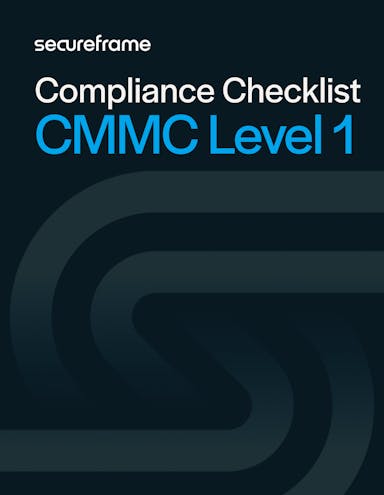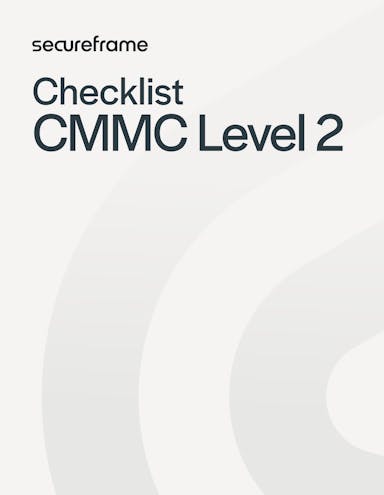
CMMC Self-Assessment: What Contractors Need to Know for Phase 1 of the Rollout
Anna Fitzgerald
Senior Content Marketing Manager
Rob Gutierrez
Senior Cybersecurity and Compliance Manager, CISA, CCSK, CMMC RP
The Department of Defense (DoD) is beginning the phased rollout of new contractual requirements on November 10, 2025, starting with CMMC self-assessment requirements. That means contractors and subcontractors will need to demonstrate compliance with CMMC Level 1 or Level 2 requirements through a formal self-assessment process before award.
If your organization is preparing to bid on or maintain defense contracts past this date, keep reading. We’ll cover how self-assessments work, who needs to complete them, and how the right tool can accelerate the self-certification process so you’re ready for enforcement.
If you’re new to CMMC 2.0, check out our on-demand webinar that explains what this framework requires, who it applies to, and how to get certified.
What is a CMMC self-assessment?
A CMMC self-assessment is the process of evaluating your own information system against CMMC Level 1 or Level 2 practices to see if you are in compliance with the 15 basic safeguarding requirements for FCI specified in FAR Clause 52.204-21 or the 110 requirements of NIST 800-171, respectively.
Instead of having a certified third-party (a C3PAO) perform the assessment, your team is responsible for completing a self-assessment internally or with a third party assisting. It is also responsible for documenting and reporting those results, along with an executive affirmation of compliance, in the Supplier Performance Risk System (SPRS) to achieve a current CMMC status.
This self-assessment process is designed to help the DoD verify that suppliers are capable of protecting sensitive unclassified information on their behalf before awarding or renewing contracts. These contracts contain information that is important to national security, but pose relatively low risk, including Federal Contract Information (FCI) and non-critical Controlled Unclassified Information (CUI) and Security Protection Data (SPD).
But this self-assessment process is not just designed to benefit the DoD—it’s also designed to help contractors, subcontractors, service providers in the Defense Industrial Base (DIB):
- Maintain eligibility for existing and new contracts
- Verify and demonstrate that required CMMC controls are in place
- Identify and document gaps in their compliance posture
- Build a roadmap for achieving CMMC certification at the required level, or higher
For these reasons, a self-assessment can be both a compliance checkpoint for maintaining or bidding on contracts with sensitive but lower risk unclassified information and a readiness exercise for the more rigorous third-party assessments required for more critical programs and contracts.

Recommended reading

Everything You Need To Know About CMMC 2.0 Certification: Requirements, Assessments, And Costs
Who needs to complete a self-assessment in Phase 1?
During Phase 1 of the phased implementation plan described in 32 CFR § 170.3 (e), the DoD will require self-assessments for a majority of new defense contracts, including:
- All contractors handling Federal Contract Information (FCI): They must complete an annual Level 1 self-assessment and submit the results along with an affirmation of compliance in SPRS to demonstrate and verify that 15 basic safeguarding practices are in place.
- A small percentage of contractors handling less sensitive CUI and SPD will be required to perform Level 2 self-assessments to be eligible for contract award. These results, including a score ranging from -203 to 110 based on the implementation of NIST SP 800-171 requirements, and executive affirmation must be submitted in SPRS.
In the 32 CFR rule, the DoD estimated the number of entities in the DIB that would eventually achieve CMMC certification by assessment level and type. They estimated that, in total, 63% would complete a Level 1 self-assessment and only 2% would complete Level 2 self-assessment.
Starting in Phase 2, although DoD contracting officials do have discretion to add this requirement in contracts during Phase 1, the vast majority (95%) of contracts with a Level 2 requirement will require third-party assessments. But Phase 1 allows a small percentage to achieve Level 2 self-certification.

Image Source: Impact and Cost Analysis of the Revised CMMC Program in 32 CFR rule
Recommended reading

The CMMC 2.0 Timeline: When Did CMMC 2.0 Go Into Effect & What's The Latest Compliance Deadline?
What if your contract doesn’t include a CMMC Level 1 or 2 (Self) requirement in November?
Even if your November contracts don’t explicitly include CMMC Level 1 (Self) or Level 2 (Self), completing a self-assessment can pay off.
Here are some reasons organizations may seek CMMC self-certification now, before it’s required:
- Stay in (or climb) the supply chain with primes. Many primes are already requiring subcontractors to demonstrate CMMC readiness—Lockheed Martin, for example, starting reaching out to suppliers that had unimplemented CMMC controls in June. Showing a current self-assessment (with results, scores, and executive affirmation in SPRS) signals low risk and makes awarding or renewing subcontracts easier.
- De-risk future phases. Contractual requirements increase in later phases. Proactively completing a self-assessment can surface gaps while there’s still time to remediate—before third-party assessments or tighter award windows kick in.
- Win new opportunities. If your pipeline includes DoD or federal bids with the Defense Logistics Agency (DLA) and Department of Energy, for example,, being able to demonstrate CMMC status—even when not required—can be a huge competitive advantage.
- Leverage overlap and formalize existing compliance efforts. If you’re already aligned to NIST 800-171 (or similar federal frameworks such as NIST 800-53 or FedRAMP), a CMMC self-assessment formalizes that work and provides increased assurance to government contractors, primes, and internal stakeholders.

Bottom line: a voluntary CMMC self-assessment can be a fast, low-cost way to build trust, reduce surprises or delays later, and create a competitive edge—whether you’re aiming for CMMC Level 1 or 2 certification now or preparing for higher levels later.
Let’s take a closer look at the self-assessment requirements of these two different levels.
| Level 1 self-assessment | Level 2 self-assessment | |
|---|---|---|
| Percentage of DIB | 63% | 2% |
| Data scope | FCI only, including supplier information and technical specification | Less sensitive CUI or SPD, including export controlled information |
| Security requirements | 15 requirements from FAR 52.204-21, including 58 assessment objectives | 110 requirements from NIST SP 800-171, including 320 assessment objectives |
| SPRS reporting requirements | Self-assessment results, result of MET or NOT MET, and executive affirmation submitted in SPRS | Self-assessment results, score ranging from -203 to 110, and executive affirmation submitted in SPRS |
| POA&Ms | Not permitted | Permitted if minimum score achieved (88 to 109) and certain requirements aren’t on the POA&M |
CMMC Level 1 self-assessment requirements
Specified in 32 CFR § 170.15, Level 1 self-assessment requirements include:
- Achieving a MET result for all 15 requirements for FCI specified in FAR Clause 52.204-21
- Scoring the self-assessment as MET (or NOT MET) in its entirety
- Submitting self-assessment results and score into the SPRS
- Submitting an executive affirmation of compliance in SPRS
Since each of the 15 Level 1 requirements and 58 assessment objectives must be fully implemented to achieve a CMMC Status of Final Level 1 (Self), there is no Plan of Action and Milestones (POA&M) allowed at this level. To maintain this status, the OSA must complete the steps above annually.
Who do these requirements apply to?
CMMC Level 1 (Self) will be the most common requirement for small businesses and subcontractors in Phase 1 and subsequent phases of the rollout, applying to approximately 63% of the DIB.
Because it requires implementing 15 practices aligned with FAR 52.204-21, such as using antivirus software, restricting physical access to systems, and ensuring employees use strong passwords, organizations should seek CMMC Level 1 certification if they want to:
- Maintain eligibility for existing contracts and new awards after November 10, 2025
- Strengthen their baseline cybersecurity posture.

CMMC Level 1 Compliance Checklist
Download this checklist to guide and assess your implementation of all 15 requirements and 58 assessment objectives required at this level before enforcement begins.
CMMC Level 2 self-assessment requirements
Specified in 32 CFR § 170.16, Level 2 self-assessment requirements to achieve a final status include:
- Achieving a MET result for all security requirements in NIST 800-172 Revision 2
- Scoring the self-assessment until the maximum score of 110 is achieved
- Submitting self-assessment results and score into the SPRS
- Submitting an executive affirmation of compliance in SPRS
To maintain this status, the OSA must complete a self-assessment and submit the results and score in SPRS every three years and the executive affirmation annually.
Unlike Level 1, Level 2 entities can achieve a conditional status of Level 2 (Self) if they meet the following requirements:
- Implements enough security requirements in NIST 800-172 Revision 2 to achieve minimum score of 88 (with POA&Ms in place)
- Documents any unmet requirements in a POA&M
- Does not include any of the requirements listed in 32 CFR 170.21(a)(2)(iii) in the POA&M
- Remediate all NOT MET requirements and perform a POA&M closeout self-assessment within 180 days (6 months) of the Conditional CMMC Status Date
If they do not close out the POA&M within the 180-day timeframe, their conditional status will expire and the OSA will be ineligible for additional awards with a Level 2 (Self) requirement. If they do close it out within the timeframe, then they will achieve the CMMC Status of Final Level 2 (Self).
Who do these requirements apply to?
CMMC Level 2 (Self) will be a relatively rare requirement for contractors and subcontractors in Phase 1 and in subsequent phases of the rollout, applying to approximately 2% of the DIB.
This contractual requirement will apply to organizations handling more sensitive unclassified information, like controlled technical information, export controlled information, and critical infrastructure data, and involve more rigorous self-assessment requirements than Level 1. However, because the CMMC Level 2 (Self) requirement is for a select number of “non-prioritized acquisitions” where the CUI or SPD is considered lower risk, it is not as rigorous as CMMC Level 2 (C3PAO).
Performing a CMMC self-assessment, particularly for a Level 2 (Self) requirement, can be confusing and time-consuming. Let’s go over the process below so you can navigate it more easily.

CMMC Level 2 Compliance Checklist
Download this checklist to guide and assess your implementation of all 110 NIST 800-171 requirements required at this level before enforcement begins.
How to conduct a CMMC self-assessment
A self-assessment doesn’t have to be overwhelming. Here’s a step-by-step breakdown of the self-assessment process, using guidance from the DoD’s CMMC Level 1 Self-Assessment Guide and CMMC Level 2 Self-Assessment Guide.
1. Identify the correct assessment level
A successful CMMC self-assessment follows similar steps to a third-party assessment, but you’re running it yourself (or optionally with a third-party partner assisting).
Start by confirming which level applies:
- If you only handle FCI, complete a CMMC Level 1 self-assessment.
- If you handle non-critical CUI or SPD, complete a CMMC Level 2 self-assessment.

2. Review the security requirements
Level 1 includes 15 basic safeguarding requirements and 58 assessment objectives. To demonstrate Level 1 compliance, the OSA will need a finding of MET or NOT APPLICABLE on all Level 1 security requirements.
Level 2 maps to the 110 controls in NIST SP 800-171 and 320 assessment objectives. To demonstrate final Level 2 compliance, the OSA will need a finding of MET or NOT APPLICABLE on all Level 2 security requirements.
3. Specify scope
Next, define scope. The CMMC Self-Assessment Scope identifies which assets within the contractor’s environment will be assessed and the details of the self-assessment.
For a CMMC Level 1 self-assessment, the assets that process, store, or transmit FCI are considered in scope and should be assessed against the CMMC Level 1 practices.
For a CMMC Level 2 self-assessment, the assets that process, store, or transmit CUI and assets that provide security protections for these assets are considered in scope and should be assessed against the CMMC Level 2 practices. These fall into one of four asset categories defined in 32 CFR § 170.19(c)(1). You can read more about them in our guide to scoping.
3. Perform a gap analysis
Now, you’re ready to perform a gap analysis and build your remediation plan. If you’re taking a manual approach, you can use the official DoD self-assessment guides for Level 1 and 2 to determine whether each practice is MET (or NOT APPLICABLE).
For Level 1, you must achieve MET/NA across all requirements since POA&Ms aren’t allowed so you have to close all gaps before moving forward.
For Level 2, you must achieve MET/NA across all requirements to achieve a final certification, but there is opportunity for a conditional status. So during this step, assess your implementation of all NIST SP 800-171 requirements and calculate your SPRS score (from –203 to 110) based on all MET and NOT MET findings. If you’re short of 110, create a POA&M with clear owners and dates—but remember that certain requirements can’t be left on a POA&M and that you will only have 180 days to remediate from your conditional status date.
Performing this gap analysis, compiling all the evidence, and managing remediation efforts manually can feel like playing a game of whack-a-mole. A CMMC automation tool can simplify this step for you. It can collect all evidence for you and map controls along with its assessment objectives, implementation status, and evidence to requirements so you can see exactly where you stand in terms of CMMC readiness.
4. Score your implementation
Once your assessment is complete, you’ll need to score your results. For Level 1, there is no numerical value. You score your assessment as MET if all 15 requirements and assessment objectives are fully implemented—or NOT MET if they aren’t.
For Level 2, assessment results are given a numerical score. You are given one, three, or five points based on the NIST 800-171 requirements you have fully implemented. This produces your SPRS score, which must be submitted in the SPRS.

Image source: CMMC.com Requirement Explorer
5. Document UNMET requirements in POA&M (Level 2 only)
If your CMMC Level 2 self-assessment doesn’t achieve the maximum score of 110, record every NOT MET requirement in a POA&M. For each item, note the requirement ID, gap description, affected assets, interim/compensating measures, discrete remediation tasks, owners, resources, and target dates.
To move forward, you must ensure you achieve a minimum score of 88 that’s required for Conditional Level 2 (Self) status and remember that certain requirements cannot be placed on a POA&M. You must update your SSP to reflect both current and planned implementation status of all requirements, then track remediation to completion.
Plan to complete the POA&M closeout self-assessment within 180 days of the conditional status date to convert to Final Level 2 (Self).
6. Submit your results in SPRS
Finally, you must submit your self-assessment results, scores, and affirmations in SPRS. You must do so annually to maintain Level 1 certification. To maintain Level 2 (Self), you must submit results and a score at least every three years and the affirmation of compliance annually.
Why CMMC self-assessments must be submitted to SPRS
Completing a self-assessment is not enough to achieve a valid CMMC status that will make your organization eligible for contract awards with a Level 1 (Self) or Level 2 (Self) requirement. You must also submit your results every three years and affirm compliance every year in the SPRS.
Why? The DoD and prime contractors use these self-assessment results and scores to inform their decision-making when acquiring or maintaining relationships with vendors and suppliers. While only the DoD has access to an organization's self-assessment information in SPRS, primes are responsible for verifying that subcontractors have a current CMMC status in SPRS.
Completing a self-assessment and submitting these results in SPRS provides government sponsors as well as primes with increased assurance and confidence that the contractor actually meets CMMC Level 1 or 2 practices.
Recommended reading

SPRS and CMMC: How to Get a Current CMMC Status to Stay Eligible for DoD Contracts After November 2025
Using a CMMC self-assessment tool to streamline compliance
Implementing 15 controls and 58 assessment objectives for CMMC Level 1 and 110 controls and 320 assessment objectives for CMMC Level 2 to complete a self-assessment one time can be hard enough. But monitoring those controls, managing evidence, keeping policies and procedures up to date, and completing all the other activities to maintain CMMC compliance every year can add to the burden of maintaining certification.
That’s where a CMMC self-assessment tool like Secureframe can help make CMMC Level 1 and 2 compliance more manageable.
With the right automation tool, you can:
- Conduct a gap assessment and map your existing controls to CMMC requirements
- Track implementation status in real time
- Track and monitor your SPRS score in real time as you make progress and as your systems and control changes
- Automatically collect evidence and monitor controls via integrations with federal cloud environments and other tools in your tech stack
- Manage evidence and documentation, including SSP and POA&Ms, in one secure platform
By moving beyond manual spreadsheets and folders, you’ll not only simplify compliance to prepare for the deadline—you’ll also be better prepared for future self-assessments as well as third-party audits to maintain CMMC certification or achieve it at a higher level in the future.
Recommended reading

The Cost and Time Savings of CMMC Compliance Automation
How Secureframe can help you prepare for a CMMC self-assessment at speed
Whether you’re preparing for a CMMC Level 1 self-assessment or a CMMC Level 2 self-assessment, Secureframe gives you a purpose-built solution that replaces manual spreadsheets with automated workflows for evidence collection, documentation, continuous monitoring, and more—so you can get certified faster and with confidence.
Here’s all the ways Secureframe simplifies CMMC self-certification:
- Gap analysis and readiness: Instantly see where you stand against Level 1 or Level 2 requirements and their associated assessment objectives, and prioritize fixes by linking POA&M items with clear owners and due dates.
- Automated evidence collection: Deep integrations with AWS GovCloud and other federal clouds automatically pull the evidence you need for each control so you don’t have to collect screenshots and other artifacts and manage them in folders and spreadsheets.
- Real-time SPRS scoring: Secureframes tracks the implementation status of each CMMC requirement and its assessment objective(s) and automatically generates your SPRS score as you work through the platform—so you always know if you’re CMMC ready and contract-eligible.
- SSP, POA&M, and documentation management: Generate and maintain your SSP, POA&M, policies, procedures, and other documentation in one place. These are mapped to CMMC and NIST 800-171 requirements and automatically filled in with data from your controls, vendors, policies, and other modules in the Secureframe platform.

- Continuous monitoring: Real-time dashboards and reporting via 300+ integrations keep you informed about failing controls or evidence so you can remediate them quickly before they affect your SPRS score or contract eligibility.
- Asset, vendor, and risk management: Secureframe integrates with your infrastructure to automatically discover in-scope assets and link them to required CMMC practices. You can also inventory and track vendors—especially those storing or transmitting CUI or providing security functions—to ensure they meet flowdown requirements. And you can assess, manage, and remediate risk to those assets and vendors using our automation and AI workflows.
- Trust Center: Showcase your compliance posture and continuous monitoring in real-time through a fully customized Trust Center to to establish transparency and trust and differentiate yourself from competitors. Check out ours as an example.
- In-platform training: Deliver role-based, insider-threat, and security awareness training that meets CMMC expectations to all employees and track who has completed it.
- Multi-framework mapping: Secureframe maps CMMC controls and tests across framework requirements so your efforts scale to similar frameworks like like NIST 800-53, FedRAMP, NIST CSF, TX-RAMP, CJIS, and more. This saves time, reduces duplication, and streamlines evidence collection across all your compliance initiatives.
Secureframe turns a one-time CMMC self-assessment into an always-current compliance program so you’re bid-ready in Phase 1 and beyond. Request a demo to learn more.
Use trust to accelerate growth
FAQs
What does self-assessment mean for CMMC?
A CMMC self-assessment is an internal evaluation that an organization seeking assessment (OSA) performs on its own contractor information system(s) against the security requirements for CMMC Level 1 or 2.
How do CMMC self-assessment requirements compare for Level 1 and 2?
For Level 1, you must achieve MET on all 15 requirements during the self-assessment and submit these results along with an executive affirmation of compliance in SPRS. POA&Ms aren’t allowed at this level.
For Level 2, you must assess against 110 NIST SP 800-171 requirements and produce a scored result used for SPRS and contract eligibility.
Can a third party assist in a CMMC self-assessment?
Yes, while contractors can perform the annual self-assessment internally, they may choose to engage a third party to assist with evaluating or preparing for their readiness for Level 1 or 2 (self) compliance. Use of a third-party to assist is still considered a self-assessment, as stated in the DoD’s CMMC Self-Assessment Guides.
How to submit CMMC level 1 self-assessment?
To submit a CMMC Level 1 self-assessment in SPRS, follow these steps:
- Ensure you have the SPRS Cyber Vendor User role in PIEE.
- Log in to SPRS → Cyber Reports → CMMC Assessments and select “Add New Level 1 CMMC Self-Assessment.”
- Enter assessment details, then transfer to your Affirming Official (AO) if needed.
- The AO reviews and affirms. Note: a Final Level 1 Self-Assessment expires after 1 year, and Level 1 requires meeting the FAR 52.204-21 safeguards.
What is the NIST 800-171 self-assessment?
It’s the DoD “Basic” self-assessment against NIST SP 800-171 (110 requirements) using the DoD Assessment Methodology that produces a score from –203 to 110. Summary scores (and related details like SSP name and date) are posted in SPRS per DFARS 252.204-7019/7020 and are commonly used to satisfy CMMC Level 2 self-assessment reporting.
What is the difference between a CMMC Level 1 and Level 2 self-assessment?
There are four key differences between a CMMC Level 1 and Level 2 self-assessment:
- Data scope: Level 1 = FCI; Level 2 = CUI.
- Requirements: Level 1 = 15 safeguards (FAR 52.204-21); Level 2 = 110 requirements (NIST SP 800-171).
- Reporting: Level 1 results are affirmed in SPRS; Level 2 results include a scored SPRS submission.
- POA&Ms: Not permitted for Level 1; permitted with constraints at Level 2 (e.g., minimum score ratio and certain requirements can’t be on the POA&M).

Anna Fitzgerald
Senior Content Marketing Manager
Anna Fitzgerald is a digital and product marketing professional with nearly a decade of experience delivering high-quality content across highly regulated and technical industries, including healthcare, web development, and cybersecurity compliance. At Secureframe, she specializes in translating complex regulatory frameworks—such as CMMC, FedRAMP, NIST, and SOC 2—into practical resources that help organizations of all sizes and maturity levels meet evolving compliance requirements and improve their overall risk management strategy.

Rob Gutierrez
Senior Cybersecurity and Compliance Manager, CISA, CCSK, CMMC RP
Rob Gutierrez is an information security leader with nearly a decade of experience in GRC, IT audit, cybersecurity, FedRAMP, cloud, and supply chain assessments. As a former auditor and security consultant, Rob performed and managed CMMC, FedRAMP, FISMA, and other security and regulatory audits. At Secureframe, he’s helped hundreds of customers achieve compliance with federal and commercial frameworks, including NIST 800-171, NIST 800-53, FedRAMP, CMMC, SOC 2, and ISO 27001.